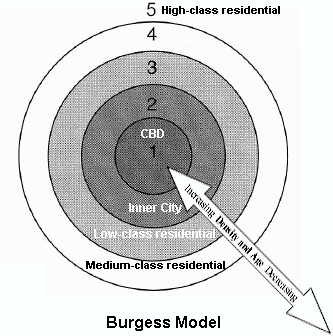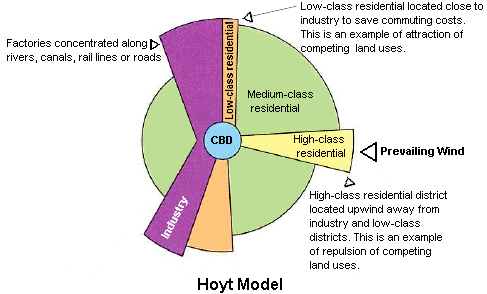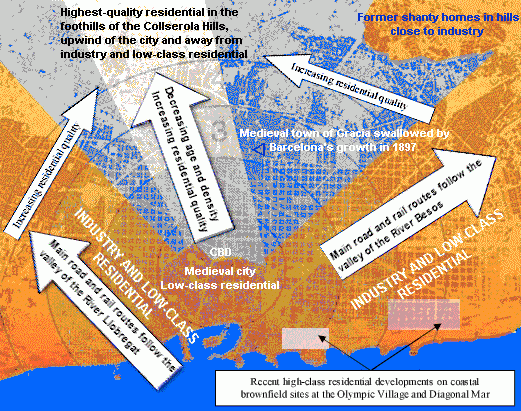Urban Land Use Patterns: MEDCs
Geographers have tried to make sense of the patterns made by urban areas and have devised a number of models which urban areas in MEDCs could be compared to. The definitions below apply to all the models.
Zone 1: Central Business District; contains the major shops, offices and entertainment facilities.
Zone 2: Inner city area (twilight zone). This is an area of old housing and light manufacturing industry. This area dates back to the Industrial revolution when it filled with coal-fired factories and tenement housing blocks.
Zone 3: Low class residential. This is an area of poor quality housing, although the conditions are better than in Zone 2.
Zone 4: Medium class residential. This is an area of housing which was built between the wars. It is mainly semidetached housing and council estates.
Zone 5: High class residential (commuter zone). This is an area of expensive housing on the outskirts of the city. It also stretches in to the countryside beyond the city.
The concentric ring model (below) was devised by Burgess. It split the land use of the city into rings, starting from the centre. The idea was that urban areas grow equally in all directions, with the oldest, most dense housing being found closest to centre.
 |
The Hoyt model (below) has land use concentrated in wedges or sectors radiating out from the city centre. For example, factories may be concentrated along a river, canal or road to form a zone of industry. This would attract low-class housing, but repel high-class residential land use.
 |
There are three explanations for these land use patterns.
1 Historical
The urban area expanded outwards from the original site which is where the city centre is found today.
2 Economic
Rents and rates in the CBD became too expensive for people. In the suburbs there was more land and it was cheaper. Only businesses could afford to stay in the CBD, but even they needed to make the most of expensive land by building upwards.
3 Concentrations of similar land uses
One part of the urban area may have all the advantages for industrial location so that a lot of factories want to locate there; but few people want to live next door to a factory, so the residential areas are located elsewhere. Planners also prefer this segregation of land uses into definite zones.
Both the Burgess and Hoyt models can be applied to the land use patterns of Barcelona as shown in the simplified land use model below:

|
||||||||||||
